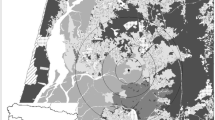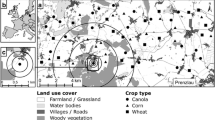Abstract
River and riparian areas provide an important foraging habitat for insectivorous bats owing to high insect availability along waterways. However, structural characteristics of the riverine landscape may also influence the location of foraging bats. We used bat detectors to compare bat activity longitudinally along river reaches with contrasting channel confinement, ratio of valley floor width to active channel width, and riparian vegetation, and laterally with distance from the river along three different reach types. We measured rates of insect emergence from the river and aerial insect availability above the river and laterally up to 50-m into the riparian habitat in order to assess the relationship between food resources and insectivorous bat activity. Longitudinally, bat activity was concentrated along confined reaches in comparison to unconfined reaches but was not related to insect availability. Laterally, bats tracked exponential declines in aquatic insects with distance from the river. These data suggest that along the lateral dimension bats track food resources, but that along the longitudinal dimension channel shape and landscape structure determine bat distributions more than food resources.





Similar content being viewed by others
References
Baxter CV, Fausch KD, Saunders WC (2005) Tangled webs: reciprocal flows of invertebrate prey link streams and riparian zones. Freshw Biol 50:201–220
Belwood JJ, Fenton MB (1976) Variation in diet of Myotis lucifugus (Chiroptera: Vespertilionidae). J Mammal 54:1674–1678
Bisson PA, Montgomery DR, Buffington JM (2007) Valley segments, stream reaches, and channel units. In: Hauer FR, Lamberti GA (eds) Methods in stream ecology, 2nd edn. Academic Press, Burlington, pp 23–49
Boothroyd IKG, Quinn JM, Langer ER, Costley KJ, Steward G (2004) Riparian buffers mitigate effects of pine plantation logging on New Zealand streams. 1. Riparian vegetation structure, stream geomorphology and periphyton. For Ecol Manage 194:199–213
Borror DJ, Johnson NF, Triplehorn CA (1989) An introduction to the study of insects, 6th edn. Saunders College Publ, Philadelphia
Brigham RM, Fenton MB (1991) Convergence in foraging strategies by 2 morphologically and phylogenetically distinct nocturnal aerial insectivores. J Zool 223:475–489
Brigham RM, Aldridge H, Mackey RL (1992) Variation in habitat use and prey selection by Yuma bats, Myotis yumanensis. J Mammal 73:640–645
Brigham RM, Grindal SD, Firman MC, Morissette JL (1997) The influence of structural clutter on activity patterns of insectivorous bats. Can J Zool 75:131–136
Cummins KW, Wilzbach MA, Gates DM, Perry JB, Taliferro WB (1989) Shredders and riparian vegetation: leaf litter that falls into streams influences communities of stream invertebrates. Bioscience 39:24–30
Erickson JL, West SD (2003) Associations of bats with local structure and landscape features in western Oregon and Washington. Biol Conserv 109:95–102
Fukui D, Murakami M, Nakano S, Aoi T (2006) Effect of emergent aquatic insects on bat foraging in a riparian forest. J Anim Ecol 75:1252–1258
Grindal SD, Morissette JL, Brigham RM (1999) Concentration of bat activity in riparian habitats over an elevational gradient. Can J Zool Rev Can Zool 77:972–977
Hagen EM (2010) Spatial and temporal patterns in insectivorous bat foraging activity in river-riparian landscapes. PhD thesis. School of Life Sciences, Arizona State University, Tempe
Henschel JR (2004) Subsidized predation along river shores affects terrestrial herbivore and plant success. In: Polis GA, Power ME, Huxel GR (eds) Food webs at the landscape level. The University of Chicago Press, Chicago, pp 189–199
Henschel JR, Mahsberg D, Stumpf H (2001) Allochthonous aquatic insects increase predation and decrease herbivory in river shore food webs. Oikos 93:429–438
Herd RM, Fenton MB (1983) An electrophoretic, morphological, and ecological investigation of a putative hybrid zone between Myotis lucifugus and Myotis yumanensis (Chiroptera: Vespertilionidae). Can J Zool Rev Can Zool 61:2029–2050
Iwata T (2007) Linking stream habitats and spider distribution: spatial variations in trophic transfer across a forest-stream boundary. Ecol Res 22:619–628
Iwata T, Nakano S, Murakami M (2003) Stream meanders increase insectivorous bird abundance in riparian deciduous forests. Ecography 26:325–337
Kusch J, Weber C, Idelberger S, Koob T (2004) Foraging habitat preferences of bats in relation to food supply and spatial vegetation structures in a western European low mountain range forest. Folia Zool 53:113–128
Larson DJ, Hayes JP (2000) Variability in sensitivity of Anabat II bat detectors and a method of calibration. Acta Chiropterol 2:209–213
Loeb SC, O’Keefe JM (2006) Habitat use by forest bats in South Carolina in relation to local, stand, and landscape characteristics. J Wildl Manage 70:1210–1218
Mackey RL, Barclay RMR (1989) The influence of physical clutter and noise on the activity of bats over water. Can J Zool 67:1167–1170
Malmqvist B (2002) Aquatic invertebrates in riverine landscapes. Freshw Biol 47:679–694
Merritt R, Cummins K, Berg MB (2008) An introduction to the aquatic insects of North America, 4th edn. Kendall/Hunt Publ, Dubuque
Montgomery DR, Buffington JM (1997) Channel-reach morphology in mountain drainage basins. Geol Soc Am Bull 109:596–611
Nakano S, Murakami M (2001) Reciprocal subsidies: dynamic interdependence between terrestrial and aquatic food webs. Proc Natl Acad Sci USA 98:166–170
O’Farrell MJ (1998) A passive monitoring system for Anabat II using a laptop computer. Bat Res News 39:147–150
Ober HK, Hayes JP (2008) Influence of vegetation on bat use of riparian areas at multiple spatial scales. J Wildl Manage 72:396–404
Paetzold A, Schubert CJ, Tockner K (2005) Aquatic terrestrial linkages along a braided-river: riparian arthropods feeding on aquatic insects. Ecosystems 8:748–759
Pierson ED (1998) Tall trees, deep holes, and scarred landscapes: conservation biology of North American bats. In: Kunz TH, Racey PA (eds) Bat biology and conservation. Smithsonian Institution Press, Washington D.C., pp 309–325
Polis GA, Anderson WB, Holt RD (1997) Toward an integration of landscape and food web ecology: the dynamics of spatially subsidized food webs. Annu Rev Ecol Syst 28:289–316
Poole GC (2002) Fluvial landscape ecology: addressing uniqueness within the river discontinuum. Freshw Biol 47:641–660
Power ME, Rainey WE, Parker MS, Sabo JL, Smyth A, Khandwala S, Finlay JC, McNeely FC, Marsee K, Anderson C (2004) River-to-watershed subsidies in an old-growth conifer forest. In: Polis GA, Power ME, Huxel GR (eds) Food webs at the landscape level. The University of Chicago Press, Chicago, pp 217–240
Racey P (1998) The importance of the riparian environment as a habitat for British bats. Symp Zool Soc Lond 71:69–91
Racey PA, Swift SM (1985) Feeding ecology of Pipistrellus pipistrellus (Chiroptera, Vespertilionidae) during pregnancy and lactation. 1. Foraging behavior. J Anim Ecol 54:205–215
Russo D, Jones G (2003) Use of foraging habitats by bats in a Mediterranean area determined by acoustic surveys: conservation implications. Ecography 26:197–209
Sabo JL, Power ME (2002) River-watershed exchange: effects of riverine subsidies on riparian lizards and their terrestrial prey. Ecology 83:1860–1869
Sabo JL, Bastow JL, Power ME (2002) Length-mass relationships for adult aquatic and terrestrial invertebrates in a California watershed. J North Am Benthol Soc 21:336–343
Sapp J, Bode C (2005) Heath and Marjorie Angelo Coast range reserve. National Center for Earth Surface-Dynamics and Power Lab. Department of Integrative Biology, University of California, Berkeley, Berkeley
Seidman VM, Zabel CJ (2001) Bat activity along intermittent streams in Northwestern California. J Mammal 82:738–747
Sleep DJH, Brigham RM (2003) An experimental test of clutter tolerance in bats. J Mammal 84:216–224
Stanford JA, Ward JV (1988) The hyporheic habitat of river ecosystems. Nature 335:64–66
Sullivan CM, Shiel CB, McAney CM, Fairley JS (1993) Analysis of the diets of Leisler’s Nyctalus leislerI, Daubenton’s Myotis daubentoni and pipistrelle Pipistrellus pipistrellus bats in Ireland. J Zool 231:656–663
Tait CK, Li JL, Lamberti GA, Pearsons TN, Li HW (1994) Relationships between riparian cover and the community structure of high desert streams. J N Am Benthol Soc 13:45–56
Thomas DW (1988) The distribution of bats in different ages of Douglas-fir forests. J Wildl Manage 52:619–626
von Frenckell B, Barclay RMR (1987) Bat activity over calm and turbulent water. Can J Zool Rev Can Zool 65:219–222
Ward JV, Tockner K (2001) Biodiversity: towards a unifying theme for river ecology. Freshw Biol 46:807–819
Warren RD, Waters DA, Altringham JD, Bullock DJ (2000) The distribution of Daubenton’s bat (Myotis daubentonii) and pipistrelle bats (Pipistrellus pipistrellus) (Vespertilionidae) in relation to small-scale variation in riverine habitat. Biol Conserv 92:85–91
Acknowledgments
Funding for our study was provided by the National Center for Earth Surface Dynamics, Bat Conservation International, and the Arizona State University Graduate and Professional Student Association. We thank B. Hinchliff and S. Berman for assistance in the field and laboratory. S. Fisher, N. Grimm, M. Schmeeckle, and J. Stromberg provided valuable comments on this manuscript. Lastly, we thank P. Steel and the University of California Natural Reserve System for providing a protected field site at the Angelo Coast Range Reserve.
Author information
Authors and Affiliations
Corresponding author
Additional information
Communicated by Christopher Johnson.
Electronic supplementary material
Below is the link to the electronic supplementary material.
Rights and permissions
About this article
Cite this article
Hagen, E.M., Sabo, J.L. A landscape perspective on bat foraging ecology along rivers: does channel confinement and insect availability influence the response of bats to aquatic resources in riverine landscapes?. Oecologia 166, 751–760 (2011). https://doi.org/10.1007/s00442-011-1913-4
Received:
Accepted:
Published:
Issue Date:
DOI: https://doi.org/10.1007/s00442-011-1913-4




